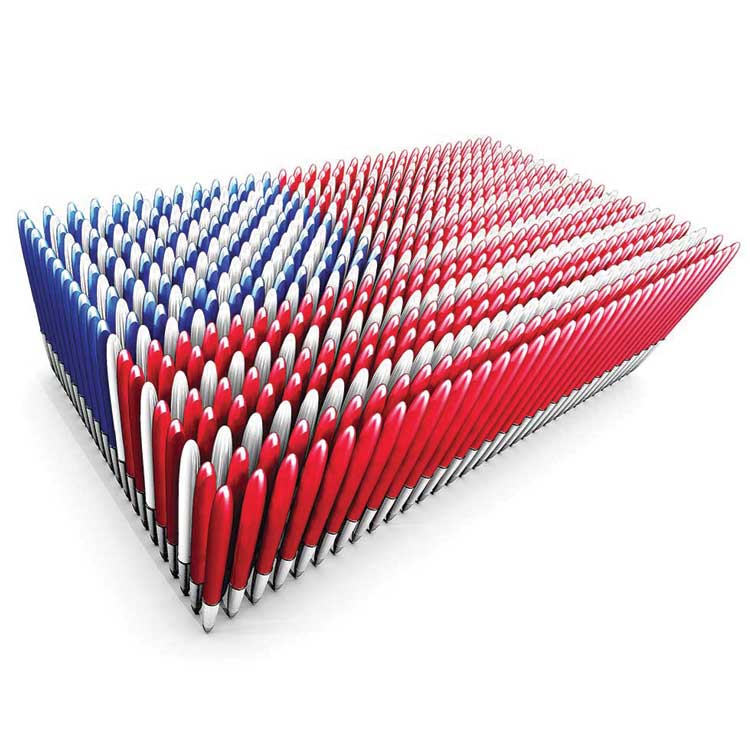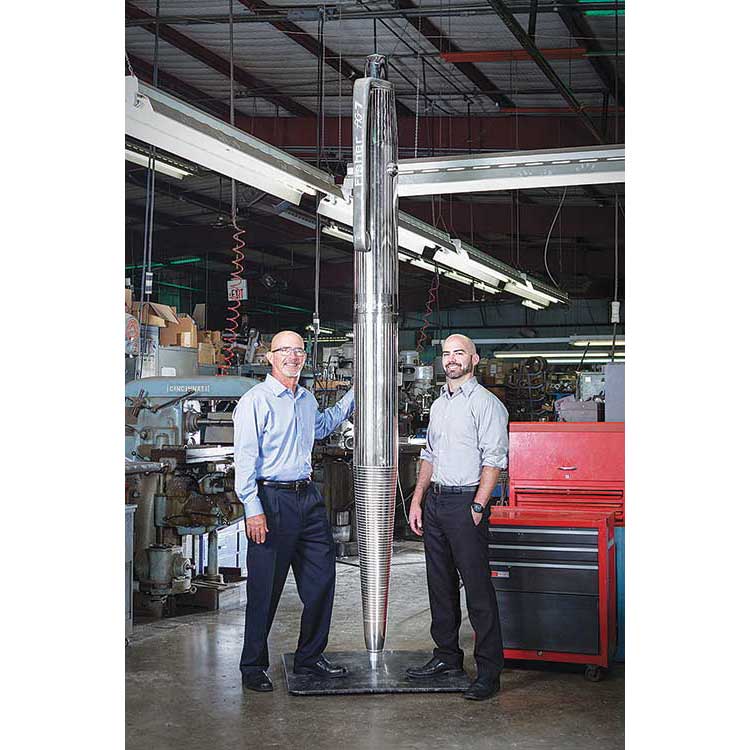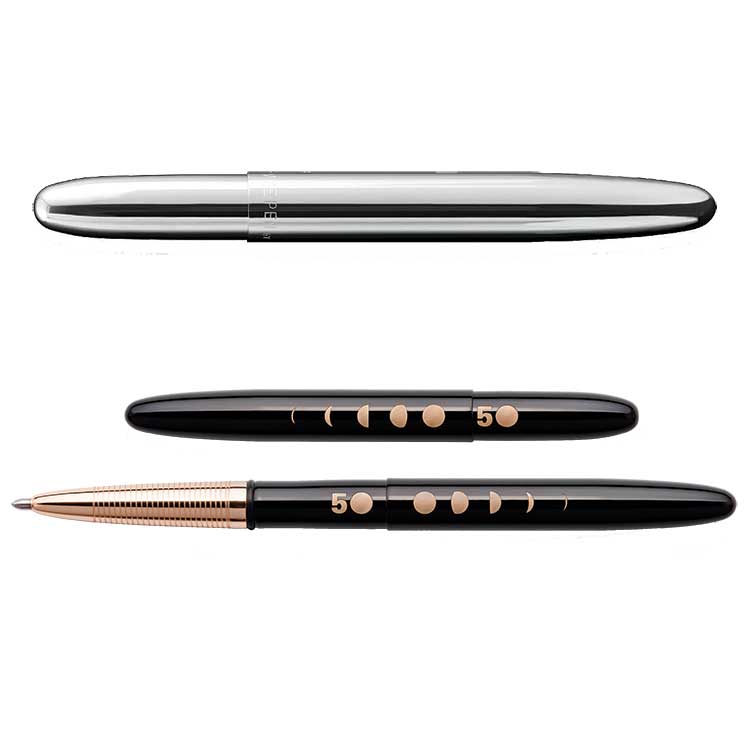August 29, 2017
Enduring Appeal of The Space Pen
The story of the gravity-defying, element-defeating Fisher Space Pen that NASA first used on missions nearly 50 years ago.
The Fisher Space Pen (asi/54423) has written the story of American space exploration.
Next year will mark the 50th anniversary that astronauts used the pen for the first time in outer space. Ever since, the pen – invented by visionary Paul C. Fisher – has been NASA’s go-to writing instrument. That’s no exaggeration. NASA used the Fisher Space Pen continuously during the space shuttle missions, and continues to deploy the pens on manned space flights today. Further, cosmonauts wrote with the pen on the Russian-run Mir Space Station. And, the Fisher Space Pen has reliably provided the ink onboard the International Space Station.
“The Space Pen was unique 50 years ago and it’s still unique today,” says retired astronaut Walter Cunningham, who wrote with the pen extensively on its first space mission in 1968.
An icon of American ingenuity, a product that weds practical function and attractive aesthetics, the Space Pen has widespread appeal beneath the clouds as well. Consumers love the pens, and promo distributors sell them liberally to clients across a spectrum of industries. Part of the permanent design collection in the Museum of Modern Art in New York, the Space Pen is displayed at the Smithsonian and Space Center, too.
It’s also a feature of the American pop culture landscape. The hit TV series Seinfeld created an episode around the Space Pen – called, you guessed it, “The Pen.” Plus, the unique writing instrument has appeared on television shows like Mad Men, The Newsroom, Gilmore Girls, Mysteries at the Museum and more. Among many other highlights, President Ronald Reagan used the Fisher Space Pen to sign the proclamation inaugurating the Air and Space Bicentennial Year to celebrate man’s first flight in a hot air balloon.

“The Space Pen represents, in many ways, who we are as a nation – what we are capable of in terms of innovation,” says Donna Jay, owner of Accolades Advertising (asi/102912), a Santa Fe, NM-based distributorship that has sold Space Pens.
What makes the Space Pen so special? What’s the story behind the invention and the enduring appeal? To find out, Counselor talked to Cunningham, Fisher Space Pen Co., NASA, and fans like Jay. What emerges is the tale of one of the most unique writing instruments ever invented.
In Pursuit of a Better Pen
Like all true innovators, the late Paul C. Fisher possessed patience, persistence and an unwavering belief that, eventually, he’d crack a conundrum.
Good thing for NASA that he did.
Back when manned space missions began, astronauts wrote with pencils onboard their spacecrafts. Unfortunately, the lead could break. That was more than irksome; it was dangerous. Floating in the capsule’s zero-gravity atmosphere, the lead could cause a short in an exposed electrical connection, sparking a fire.
As Cary Fisher, Paul’s son tells it, NASA sought help from certain pen companies, asking them to create a writing instrument that would function flawlessly in space. “None of them could do it,” says Cary, current president and co-owner of Fisher Space Pen Co. “But then they talked to a wholesaler in Dallas who told them, ‘No one experiments more than Fisher. Give them a try.’ They contacted my dad. His reaction was, ‘Where have you been?’”
Indeed, Paul Fisher had been trying to connect with the right people at the federal level about delivering a pen that would be perfect for outer space, but had been unable to break through the bureaucracy. Now, he was thrilled to have the chance. More importantly, he had the skills and know-how to deliver.
From the time Fisher founded Fisher Pen Company in 1948, he was on a quest to make a better pen – a commitment that drove him to develop a number of innovations. In 1953, for example, his efforts led to the invention of the “universal refill cartridge” for most brand-name pens. Drawing on the same steadfast, no-quit experimentation that enabled such a groundbreaking achievement, Fisher worked to develop a pressurized pen that could work without fail. “They must have gone through over 1,000 experiments without success,” says Cary, noting that his father was working on making a functional, ooze-free, pressurized pen well before NASA called. The connection to space exploration came only after Fisher realized the pen he was striving to develop could be perfect for astronauts. Says Cary: “He just wanted to make the best possible pen.”
Pushing on through every setback, Fisher succeeded in 1966 by creating a retractable, pressurized, sealed cartridge for the original AG7 Anti-Gravity Space Pen. “It was the outgrowth of years of work,” says Cary.
Now finally in with NASA, Fisher sent samples of the AG7 to Dr. Robert Gilruth, then director of the Manned Spacecraft Center, subsequently named the NASA Johnson Space Center, in Houston. NASA subjected the pen to rigorous rounds of testing. The AG7 – the Space Pen – passed them all. “The pen was certified for flight in the early space program so that astronauts would have a way to write indelibly,” says Kelly O. Humphries, news chief at the NASA Johnson Space Center.
For sure, the astronauts got a high-performance pen. The impressive original model was infused with the characteristics that continue to set Fisher’s line of Space Pens apart today. It could write deftly at zero gravity, underwater, over grease, at any angle, upside down, and in harsh temperatures ranging from -30 degrees Fahrenheit to more than 250 degrees Fahrenheit. “It worked perfectly for us on our mission,” says Cunningham.
Photo Gallery
Into the Stars
A retired astronaut and USMCR fighter pilot (rank: Colonel), Cunningham occupied the lunar module pilot seat during the 11-day space journey of Apollo 7 – the first manned flight test of the third generation of U.S. spacecraft. It was a landmark mission in many regards, including the fact that it featured the first effective television broadcast of onboard crew activities. It also, of course, marked the debut of the Fisher Space Pen.
Throughout the 263-hour flight, Cunningham and fellow astronauts Walter M. Schirra Jr. and Donn F. Eisele used AG7s when they needed to write something down. Their notes were extensive, covering aspects of a complicated mission that included measuring the performance accuracy of all spacecraft systems, testing and maneuvering ignitions of the service module propulsion engine, and much more. “The Space Pen was essential to our record keeping,” Cunningham says. “If there was a particular experiment, we would write down the results using it. We could float around in zero gravity, upside down, and write from any angle.”
In addition to documenting technical elements of the mission, the astronauts also used their AG7s to note some of the more human realities of travel beyond earth’s atmosphere. “We filled a couple pages with notes on how to go to the bathroom in space,” says Cunningham, laughing good-naturedly.
In a testament to the Space Pen’s prowess, Cunningham’s mission notes continue to be easily legible 49 years later. “They still read nice and clear,” he says.
Naturally, memories of the Apollo 7 mission have remained vivid in the 85-year-old Cunningham’s mind throughout his life. Another thing that has stayed with him over the decades is an affinity for the Fisher Space Pen. “I still use them. I have one in my pocket right now,” says Cunningham. “They were excellent for us on the mission, and they continue to work great.”
Promo Appeal
Jay shares Cunningham’s enthusiasm.
“The feel, the balance, the quality, the way they can write under almost any circumstance – I just love them and so do my clients,” says the owner of Accolades Advertising.
When it comes to the Fisher Space Pen, Jay’s end-buyers run the gamut from military, law enforcement and national parks, to schools, retailers, manufacturers, media, and even a federal legislator. “I work with a congressman who typically orders about 1,000 per go,” says Jay. “This last time he did a little under 2,000. He absolutely must have them. Not only are the pens great, they come packaged attractively. The Space Pens have the congressional seal hot-stamped in gold and the congressman’s name on them. He gives them out to donors.”
End-buyer Gabriel Reyes is also passionate about the Fisher Space Pen. The president of Reyes Entertainment, a PR and marketing firm, routinely gives the pens to clients and uses them himself. “They are special because they’re beautiful to look at and carry the space mystique,” says Reyes. “But mainly I love them because they’re highly functional, always dependable and never fail me no matter the climate or conditions.”
Apparently, Jay and Reyes aren’t alone in their appreciation of the Fisher Space Pen as a premier branded merchandise item. Last year, the promo products division of Fisher Space Pen Co. increased sales by 8%, according to division sales director Cory West. This year, Fisher’s promo products business is on track to accelerate about 15%. Giving out a lot of samples has helped propel the sales increase, according to West. “There’s a real value to having your potential clients use the pen,” he says. “That’s when they get a feel for the quality and functionality.”
As it happened, Fisher Space Pen Co. only entered the promotional products business full tilt this century. In the company’s early days, Paul C. Fisher was involved in promo products, but frustrations over issues like imprint quality and getting paid led him to exit the market. Decades on, Cary Fisher helped lead a charge back into promo – a movement that has proved a triumphant return. “I have clients who are as excited to buy the Space Pen as I am to sell them,” says Jay. “They really make quite a statement.”
A Legacy in Red, White & Blue
The excitement Jay describes is part of the lasting legacy of Paul C. Fisher. He passed away in 2006, but not surprisingly, was working on pen improvements until declining health prevented him. “He was still tinkering up until the time he was hospitalized,” says Cary.
That old-school American work ethic – the commitment to always getting better – continues to fuel operations at Fisher Space Pen Co. today. The business produces a wide range of Space Pen styles that are powered by the gravity-defying, element-defeating properties synonymous with the original. Pens with styluses, pens shaped like bullet cartridges, patriotic pens, religious-themed pens, and even the classic AG7 – all figure into Fisher’s broad product mix.
A proud American who involved himself in politics (he ran briefly for president against John F. Kennedy in 1960), Paul C. Fisher would be happy to know that the company he started continues to produce its pens in the United States. Employing about 65 people in Boulder City, NV, Fisher Space Pen. Co. remains a locally run family operation, co-owned by Cary and Donald “Dock” Wong, who has been at the company for more than 50 years. Cary asserts that stateside production offers numerous advantages. “It solves a lot of problems, from logistics to language,” he says. “Plus, we’re a bit patriotic around here.”
The red-white-and-blue ethos hasn’t gone unnoticed. AOL, in partnership with Ford, featured Fisher Space Pen Co. as the Nevada representative in This Built America, a multi-platform series that showcased the rejuvenation of manufacturing in America. Each segment told the story of one company from every state committed to U.S. manufacturing. The Fisher Space Pen also happens to be the official pen of the U.S. ski and snowboarding teams. “The Space Pen is a symbol of American innovation with global appeal,” says Reyes.
The team at Fisher Space Pen Co. is committed to building on that reputation, which Paul C. Fisher pioneered with his trailblazing pen. “My grandfather’s legacy is incredible to me,” says Cary’s son Matt Fisher, vice president of sales at Fisher Space Pen Co. “We do our best here every day to live up to that legacy and make him proud.”
– Email:cruvo@asicentral.com; Twitter: @ChrisR_ASI

Product Hub
Find the latest in quality products, must-know trends and fresh ideas for upcoming end-buyer campaigns.




